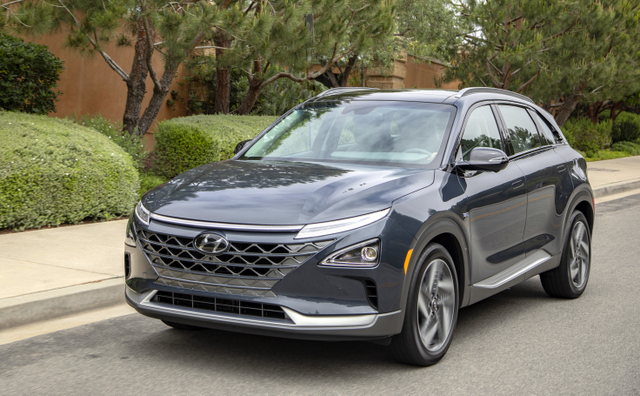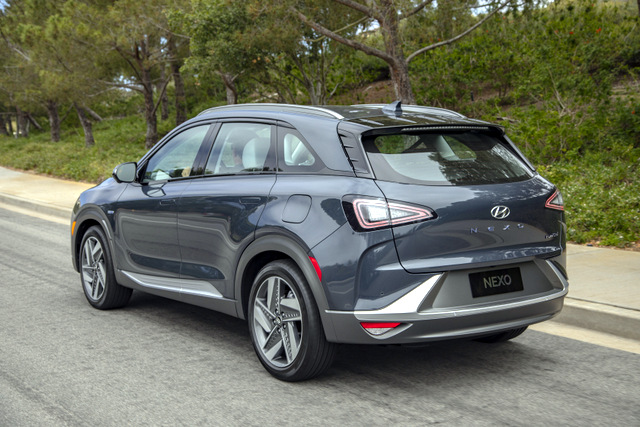The Only Hydrogen Fuel Cell SUV
While automakers focus a lot of attention on battery electric vehicles as their future products, hydrogen fuel-cell electric vehicle (FCEV) technology has been with us for a while, too. There currently are three options in the U.S. market, but the all-new Hyundai Nexo is the only one that’s an SUV.

Hyundai has offered an FCEV for several years based on its compact Tucson crossover, but you’ve likely never seen it. The Nexo is its successor, on a dedicated platform, and has improved on the Tucson in every way. It’s great looking, too, inside and out.
Upgrades All Over
The 2019 Hyundai Nexo stretches 10.3 inches longer than the Tucson, on a 5.9-inch longer wheelbase. It spreads an inch wider but sits an inch lower. That, along with numerous wind-cheating design features, gives it an impressive 0.32 coefficiency of drag (cd).

The new 161-horsepower/120-kilowatt (kW) motor replaces the 100 kW one in the Tucson, for 25 percent higher peak acceleration and a 0-60 time of just 9.5 seconds vs. the Tucson’s 12.5. The motor’s 291 pounds-feet of torque is 70 more than the Tucson. The new lithium-ion 40-kilowatt-hour (kWh) battery is way ahead of the Tucson’s 24 kWh, giving the standard model Nexo a range of 380 miles–a 115-mile boost. The entire powertrain is lighter and more efficient.
The EPA numbers are 65 city/58 highway/61 combined for miles-per-gallon-equivalent (MPGe). I averaged 57.7 MPGe during my test week.
The Science Behind the Car
The science of hydrogen fuel-cell vehicles is simple to explain, but very complicated to do. Here, we’ll accept that H1—half of the H2 in H2O (water) is combined with O (oxygen) to form only water as a byproduct. By passing the compressed hydrogen fuel through the 95-kW fuel cell’s membrane, the fuel cell generates electricity to charge the battery that powers the Nexo’s motor.
Hydrogen isn’t found as H1 in nature—it likes to combine with things—so it needs to be split off to create a transportation fuel. That takes energy, so how the fuel is made (and transported) contributes in varying degrees to carbon dioxide production.

The other complexity is that the existing hydrogen fuel distribution network is tiny. The current FCEV fleet is small and mostly confined to California (which has programs to support it), so if you live in a major urban area, fuel is available—but not elsewhere. [ed. note: The refueling situation was complicated further when soon after Steve tested his Nexo, a facility that was the chief hydrogen supplier for the region experienced an explosion that resulted in most of the stations running out of hydrogen.)
There currently are 11 hydrogen stations in the San Francisco Bay Area, where I live (and 40 in the state). I went down to the closest one and found a line of four Honda Claritys and Toyota Mirais ahead of me. I was happy to see the cars’ popularity, but this could become a problem if more people take on ownership of one of these high-tech rides and there aren’t enough stations built to fill them.
Beyond the Fuel
The 2019 Hyundai Nexo absolutely hits the mark in styling. It looks like a nice crossover, while the Honda and Toyota models are both oddly rendered sedans. My test car, in handsome Dusk Blue hue, was the Blue trim level. It comes with loads of safety and convenience features, while the Limited model above it grows the wheels from 17s to 19s and adds a sunroof, power liftgate and Remote Smart Parking Assist (RSPA). RSPA lets you park in either a parallel or perpendicular parking space without being inside the car!

Dr. Woong-chul Yang, Hyundai’s Vice Chairman, called the new Nexo an “earth-saving effort.” Besides the cleaner powertrain, it uses various ecological materials, including soybean-oil-based polyurethane paint, bamboo-thread-based bio fabric, and bio-plastic and bio-carpet extracted from sugar cane. These materials are employed in 47 different parts, reducing CO2 by 26 pounds during manufacturing.
My test Nexo provided a splendid driving experience, with an attractive light-gray interior. Its dramatic center-console bridge reminded me of Volvo interior design. The 12.3-inch center screen is well laid out, and as in other new Hyundais, everything is easy to find and use.
Both trim levels are filled with premium features, so are premium-priced as well. My Blue tester started at $58,300 plus shipping. The Limited starts at $61,800. Currently, for a limited time, you can choose 1.9 percent APR financing for up to 60 months with $7,500 off or a $399/month lease for 36 months with $2,999 down. Either way, of course, you have to live in California.

So, how adventurous are you? While plug-in electric vehicles are great, they can have issues with charging and range. Hydrogen fuel-cell electric cars let you pull into a station (as long as you can find one) and fill up in five minutes (as long as there’s not a big line). However, you can’t go far out of California with one, which is another form of range anxiety. Regardless, Hyundai’s new Nexo FCEV is a huge step forward.
Make sure to opt-in to the Clean Fleet Report newsletter (top right of page) to be notified of all new stories and vehicle reviews.
Related Stories You Might Enjoy—Fuel Cell contenders
Road Test: 2019 Hyundai Nexo Fuel Cell CUV (Gary’s view)
Road Test: 2017 Hyundai Tucson Hydrogen Fuel Cell
First Drive: 2017 Honda Clarity Fuel Cell Electric
Road Test: 2019 Toyota Mirai Fuel Cell
News: Toyota Mirai Sales Mark
Flash Drive: 2017 Toyota Mirai FCEV
News: Mercedes GLC F-Cell Coming
In order to give you the best perspective on the many vehicles available, Clean Fleet Report has a variety of contributors. When possible, we will offer you multiple perspectives on a given vehicle. This comes under SRO-Second Road Test Opinion. We hope you’ll enjoy these diverse views–some are just below—and let us know what you think in comments below or at publisher@cleanfleetreport.com.
Disclosure:
Clean Fleet Report is loaned free test vehicles from automakers to evaluate, typically for a week at a time. Our road tests are based on this one-week drive of a new vehicle. Because of this we don’t address issues such as long-term reliability or total cost of ownership. In addition, we are often invited to manufacturer events highlighting new vehicles or technology. As part of these events we may be offered free transportation, lodging or meals. We do our best to present our unvarnished evaluations of vehicles and news irrespective of these inducements.
Our focus is on vehicles that offer the best fuel economy in their class, which leads us to emphasize electric cars, plug-in hybrids, hybrids and diesels. We also feature those efficient gas-powered vehicles that are among the top mpg vehicles in their class. In addition, we aim to offer reviews and news on advanced technology and the alternative fuel vehicle market. We welcome any feedback from vehicle owners and are dedicated to providing a forum for alternative viewpoints. Please let us know your views at publisher@cleanfleetreport.com.

1 thought on “Road Test: 2019 Hyundai Nexo Fuel Cell”